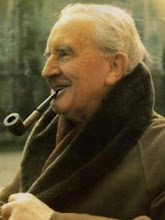
No one responded to my challenge the other day! Here are the answers. I asked whether anyone could spot any discrepancies between the section of Canto IV which I posted and the published Silmarillion. There are only three, although they are quite significant. The first is Tolkien's use of the term ''Gnomes'' to refer to the Noldoli (later Noldor). I suppose Tolkien's intent, when he composed the Lost Tales, in his selection of that term was its phonetic suitability, much like Elves, Orcs and Ents, and its ''wisdom'' connotation. He continued to use it for many years, and it even appeared in early drafts of The Hobbit. However, he later abandoned it. In a draft for the last paragraph of Appendix F of The Lord of the Rings, Tolkien wrote:
''I have sometimes (not in this book) used 'Gnomes' for Noldor and 'Gnomish' for Noldorin. This I did, for whatever Paracelsus may have thought (if indeed he invented the name) to some 'Gnome' will still suggest knowledge. Now the High-elven name of this people, Noldor, signifies 'those who know;' for of the three kindreds of the Eldar from their beginning the Noldor were ever distinguished both by their knowledge of things that are and were in this world, and by their desire to know more. Yet they in no way resembled the Gnomes either of learned theory or popular fancy; and I have now abandoned this rendering as too misleading. For the Noldor belonged to a race high and beautiful, the elder Children of the world, who now are gone. Tall they were, fair-skinned and grey-eyed, and their locks were dark, save in the golden house of Finrod [Finarfin]...'' (The History of Middle-earth, Volume I, The Book of Lost Tales Part I, Chapter I).
Regarding the ''wisdom'' connotation of the word ''gnome.'' The Greek gnōmē conveys ''thought'' or ''intelligence'' and in its plural form ''proverbs'' or ''sayings.'' The 16th century writer Paracelsus used the term as a synonym of pygmaeus. Paracelsus ''says that the beings so called have the earth as their element...through which they move unobstructed as fish do through water, or birds and land animals through air.'' (Oxford English Dictionary s.v Gnome). The Oxford English Dictionary suggests that whether Paracelsus invented the word himself or not it was intended to mean ''earth-dweller,'' and discounts any connexion with the other word gnome. There is a reference to this in The Letters of J.R.R Tolkien too, no. 239.
The next discrepancy is to be found in lines 1102-1103 where Tolkien makes mention of two people, Finrod and Felagund. Finrod was the original name of Finarfin, and confusingly the name Finrod became the name of his son in later legends - although it makes more sense because the form is Sindarin. Felagund's older name was Inglor. Felagund was a name that the Dwarves gave him, in view of the fact that he delved for his dwelling the caves of Nargothrond, and it means ''Hewer of Caves.'' As the work is so vast, I haven't been able to pin-point the exact point when the names were rearranged, but often Christopher Tolkien himself, the greatest of all Tolkien scholars, is unable to provide a definitive answer.
The third discrepancy is of course Tolkien's spelling of Dairon for Daeron. The form was changed (for the better in my opinion) late in the legends, as can be seen when after the publication of The Lord of the Rings, Tolkien returned to the Lay, creating substantial edits to the Lay, and began to use the newer form. The Lay was, of course, never finished.

No comments:
Post a Comment